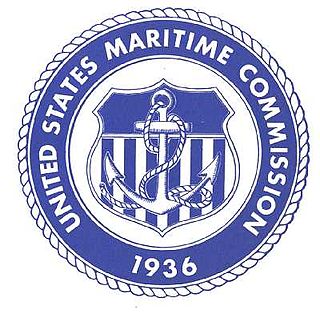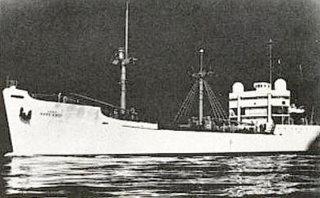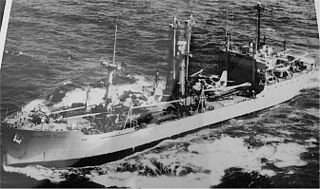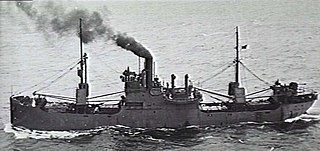
Liberty ships were a class of cargo ship built in the United States during World War II under the Emergency Shipbuilding Program. Although British in concept, the design was adopted by the United States for its simple, low-cost construction. Mass-produced on an unprecedented scale, the Liberty ship came to symbolize U.S. wartime industrial output.

The United States Maritime Commission (MARCOM) was an independent executive agency of the U.S. federal government that was created by the Merchant Marine Act of 1936, which was passed by Congress on June 29, 1936, and was abolished on May 24, 1950. The commission replaced the United States Shipping Board which had existed since World War I. It was intended to formulate a merchant shipbuilding program to design and build five hundred modern merchant cargo ships to replace the World War I vintage vessels that comprised the bulk of the United States Merchant Marine, and to administer a subsidy system authorized by the Act to offset the cost differential between building in the U.S. and operating ships under the American flag. It also formed the United States Maritime Service for the training of seagoing ship's officers to man the new fleet.

The War Shipping Administration (WSA) was a World War II emergency war agency of the US government, tasked to purchase and operate the civilian shipping tonnage the United States needed for fighting the war. Both shipbuilding under the Maritime Commission and ship allocation under the WSA to Army, Navy or civilian needs were closely coordinated though Vice Admiral Emory S. Land who continued as head of the Maritime Commission while also heading the WSA.

SS A. J. Cermak was a Liberty ship built in the United States during World War II. She was named after Anton Cermak, an American politician. Cermak was the Mayor of Chicago from 1931 until his assassination in 1933 while meeting with President Franklin D. Roosevelt.
SS Clara Barton was a standard Liberty ship, Type EC2-S-C1, built by the California Shipbuilding Corporation, Terminal Island, for the United States Maritime Commission and delivered to the War Shipping Administration (WSA) for operation as allocated by WSA during World War II. She was named after Clara Barton, the founder of the American Red Cross. The ship survived the war only to suffer the same fate as nearly all other Liberty ships that survived did; she was scrapped in 1970.
SS Russell A. Alger,, was a Liberty ship named after Russell A. Alger, a Michigan Senator, Governor and U.S. Secretary of War.

Booker T. Washington was a United States Maritime Commission (MC) Liberty ship and the first major oceangoing ship and first of 17 Liberty ships that were named after African-Americans. The ship was named for Booker T. Washington, notable educator, author, orator, and advisor to presidents of the United States. At launch Mary McLeod Bethune gave the address and notable singer Marian Anderson christened the ship.

Harry L. Glucksman was a 7,198 GRT Liberty ship built by the Southeastern Shipbuilding Corporation of Savannah, Georgia, launched on 29 April 1944, delivered to the War Shipping Administration 20 May 1944, and sailing in convoy from New York to the United Kingdom on 10 June. The ship was laid up 29 May 1948 with two withdrawals from reserve 20 November 1951 – 9 June 1952 and 29 November 1956 – 31 March 1958, the second withdrawal for transporting coal to Europe. The ship remained in reserve until transferred permanently to the United States Navy which completely gutted the ship in a conversion to become a "device," designated Minesweeper, Special, MSS-1, for the Atlantic Fleet Mine Force research and development project intended to develop an unsinkable hull equipped with magnetic coils to increase its magnetic signature for the detonation of magnetic mines and using its hull pressure to detonate pressure mines. MSS-1 was placed out of service 15 March 1973 and returned to the Maritime Administration (MARAD) for disposal on 2 September 1975.

USS Mizar (AF-12) was the United Fruit Company fruit, mail and passenger liner Quirigua that served as a United States Navy Mizar-class stores ship in World War II.
MS Tunis was a Danish motor ship in commercial service for Det Forenede Dampskibs Selskab (DFDS), Copenhagen, Denmark, as a cargo ship delivered to DFDS on 15 January 1936. Tunis was the first of four sister ships, two built in 1936 and two in 1938, that operated for DFDS. The ship's normal service was Copenhagen to the Mediterranean until war in Europe when all four of the ships were put into Atlantic service.

The Type C4-class ship were the largest cargo ships built by the United States Maritime Commission (MARCOM) during World War II. The design was originally developed for the American-Hawaiian Lines in 1941, but in late 1941 the plans were taken over by the MARCOM.

USS Majaba (AG-43/IX-102) was the Design 1049 cargo ship Meriden built in 1919 by the Albina Engine & Machine Works, Portland, Oregon. All the ships were requisitioned by the United States Shipping Board (USSB) for World War I service. The ship was bought by the E. K. Wood Lumber Co., of San Francisco, California in 1923 and renamed El Capitan. The ship was chartered by the U.S. Navy through the War Shipping Administration (WSA) in April 1942 and commissioned as Majaba.

USNS Rose Knot (T-AGM-14) was a World War II era United States Maritime Commission small cargo ship built in 1945 and delivered to the War Shipping Administration for operation through agent shipping companies and for periods by the Military Sea Transportation Service (MSTS). In 1957 the ship was transferred to the Air Force and converted into a missile range instrumentation ship which operated as USAFS Rose Knot on the U.S. Air Force's Eastern Test Range during the late 1950s and early 1960s. Rose Knot operated under an Air Force contract with Pan American Airways Guided Missile Range Division headquartered in Cocoa Beach, Florida. In July 1964, all Air Force tracking ships were transferred to MSTS for operation with the Air Force in operational control while the ships were at sea as tracking ships. Rose Knot had special facilities for supporting the human spaceflight program and supported the early crewed flights. The ship was owned by the U.S. government until sold for non-transportation use in 1977.
USNS Lt. James E. Robinson (T-AKV-3/T-AG-170/T-AK-274) was a Lt. James E. Robinson-class cargo ship, which was launched as a World War II commercial Victory cargo ship SS Czechoslovakia Victory under the Emergency Shipbuilding program. She had earlier been the U.S. Army's USAT LT. James E. Robinson before being acquired by the U.S. Navy.

USS Pembina (AK-200) – later known as USNS Pembina (T-AK-200) -- was an Alamosa-class cargo ship that was constructed for the U.S. Navy during the closing period of World War II. She supported the end-of-war Navy effort and was subsequently placed in service with the US Army under the Shipping Control Authority for the Japanese Merchant Marine with a Japanese crew in Yokosuka, Japan.

USNS Colonel William J. O’Brien (T-AK-246) was a US Maritime Administration (MARCOM) C1-M-AV1 type coastal cargo ship, originally planned as an Alamosa-class cargo ship. Constructed as Maiden's Eye for the MARCOM, completed in August 1945 and placed in operation by the War Shipping Administration (WSA). After the war Maiden's Eye was transferred to the US Army and renamed USAT Colonel William J. O’Brien who kept her in service until transferred to the US Navy in 1950 for operation as USNS Colonel William J. O’Brien (T-AK-246) by the Military Sea Transportation Service (MSTS) until 1973.

USNS Private Frank J. Petrarca (T-AK-250) was a US Maritime Administration (MARCOM) C1-M-AV1 type coastal cargo ship, originally planned as an Alamosa-class cargo ship. Constructed as Long Splice for MARCOM, completed in September 1945 and placed in operation by the War Shipping Administration (WSA) during the closing period of World War II. However, the war ended, and she was transferred to the US Army as USAT Private Frank J. Petrarca who kept her in service until transferred to the US Navy in 1950.

SS Sea Marlin was a C3-S-A2 cargo ship operated for the War Shipping Administration (WSA) by Grace Lines during World War II. WSA allocated Sea Marlin to United States Army requirements. Sea Marlin was crewed by United States Merchant Marines, with a contingent of the US Naval Armed Guards for the guns and had a complement of the US Army Transportation Corps aboard for troop administration.

SS Lake Elsmere was an Emergency Fleet Corporation (EFC) Design 1074 cargo ship built for the United States Shipping Board (USSB) during the massive shipbuilding effort of World War I.
USAT Sicilien was the Danish motor vessel MS Sicilien built in 1938. After Germany occupied Denmark 9 April 1940 Danish ships were considered enemy ships by Britain and France and subject to seizure. Sicilien was one of forty that sought refuge in the neutral United States. On 30 March 1941 those ships were seized by the United States and requisitioned on 23 July 1941. The ship was then turned over to the United States Army for operation as a United States Army Transport.














